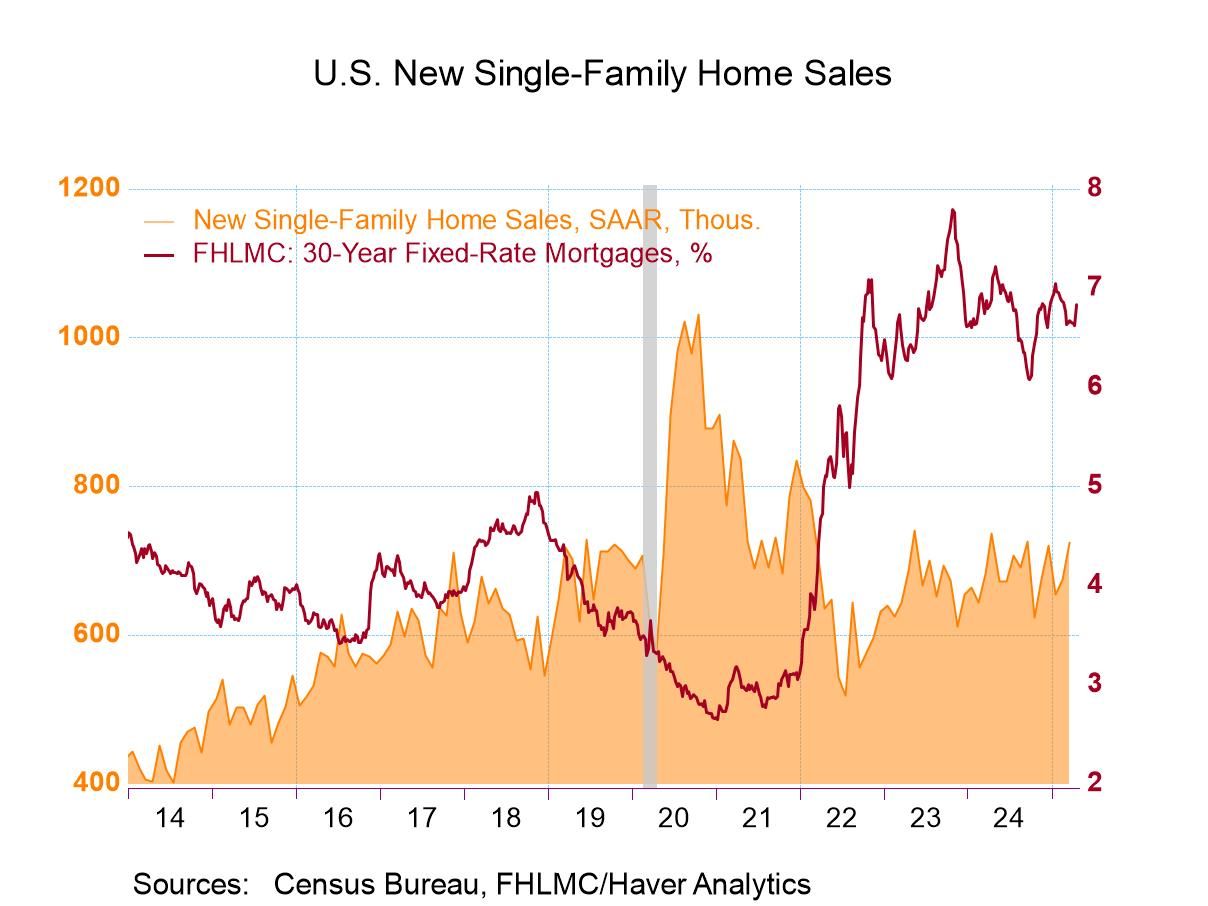U.S. Trade Deficit Narrows Slightly from Record in February
by:Tom Moeller
|in:Economy in Brief
Summary
- Goods deficit shrinks while services surplus falls.
- Exports are double January’s increase; imports are roughly steady.
- Energy product imports decline while crude oil prices stabilize.


The U.S. trade deficit in goods and services (BOP basis) in February narrowed to $122.7 billion, after widening to a record $130.7 billion in January, revised from $131.4 billion. December’s deficit of $98.1 billion was unrevised, according to the U.S. Census Bureau. A $123.5 billion deficit was expected by the Action Economics Forecast Survey. Exports rose 2.9% (4.8% y/y) in February after increasing 1.5% in January. This was accompanied by stability (+19.7% y/y) in imports which came after a 10.0% January rise. So far in Q1 the deficit has averaged $126.7 billion, after averaging $83.3 billion in Q4’24.
The deficit in goods trade (BOP basis) narrowed to $147.0 billion in February from $155.8 billion in January, revised from $156.8 billion. Goods exports (customs value) rose 3.6% (2.5% y/y) in February, after increasing 2.1% in January. The latest increase reflected a 12.7% (0.7% y/y) surge in auto exports which came after a 3.1% decline, and a 5.1% (-2.4% y/y) gain in industrial supplies & materials exports which followed a 0.7% decline. Capital goods exports rose 4.8% (12.2% y/y) after an 8.0% increase and nonauto consumer goods exports rose 2.4% (3.6% y/y) in February after an 8.4% jump. Foods, feeds & beverage exports weakened 2.7% (-12.0% y/y) following a 7.3% January drop.
Imports of goods eased 0.2% (+22.5% y/y) in February after a 12.4% January rise. Imports of industrial supplies and materials declined 4.6% (+56.6% y/y) which came after a 34.2% jump in January. Nonauto consumer goods imports rose 3.1% (24.5% y/y) following an 8.3% January gain. Capital goods imports rose 1.1% (18.2% y/y) following a 5.5% rise. Auto imports gained 1.2% (-8.5% y/y) after increasing 2.3% in January. Foods, feeds & beverage imports declined 2.0% (+8.0% y/y) following a 4.3% Increase. Petroleum imports by end-use fell 2.9% (-7.2% y/y) after a 1.3% decline. Nonpetroleum imports held steady (+24.8% y/y) after rising 13.4% in January.
The inflation-adjusted goods trade deficit (customs value) eased to $135.4 billion in February from $142.3 billion in January. Real exports rose 3.4% (0.7% y/y) after a 0.9% January increase while real imports eased 0.7% (+20.2% y/y) in February following a 12.4% January rise.
The services trade surplus narrowed to $24.3 billion in February from $25.2 billion in January. Service exports eased 0.4% (+7.3% y/y) after a 0.5% rise in January. Construction services exports rose 2.6% (43.2% y/y) after increasing 3.7% in January. Travel services exports fell 1.4% (4.7% y/y) and financial exports increased 0.9% (7.6% y/y). Transport exports fell 3.5% (+0.4% y/y). Service imports rose 0.7% (9.7% y/y) in February, the same as in January. Maintenance & repair services declined 6.1% (+25.5% y/y) while imported transport services held steady (+5.3% y/y). Imported travel services rose 1.4% (6.3% y/y) while charges for use of intellectual property rose 2.0% (28.8% y/y).
The U.S. goods trade deficit with China narrowed to a seasonally adjusted $26.6 billion in February from $29.7 billion in January. Exports to China rose 12.1% (-12.8% y/y) while imports weakened 4.6% (+8.8% y/y). The deficit with the European Union deepened to a record $30.9 billion in February from $25.5 billion in January. Exports declined 7.1% (-2.6% y/y) while imports rose 5.5% (27.2% y/y). The deficit with Japan narrowed to $5.2 billion from $7.4 billion in January. Exports rose 6.8% (6.9% y/y) and imports declined 13.0% (-1.2% y/y).
The international trade data, including relevant data on oil prices, can be found in Haver’s USECON database. Detailed figures on international trade are available in the USINT and USTRADE databases. The expectations figures are from the Action Economics Forecast Survey in AS1REPNA.


Tom Moeller
AuthorMore in Author Profile »Prior to joining Haver Analytics in 2000, Mr. Moeller worked as the Economist at Chancellor Capital Management from 1985 to 1999. There, he developed comprehensive economic forecasts and interpreted economic data for equity and fixed income portfolio managers. Also at Chancellor, Mr. Moeller worked as an equity analyst and was responsible for researching and rating companies in the economically sensitive automobile and housing industries for investment in Chancellor’s equity portfolio. Prior to joining Chancellor, Mr. Moeller was an Economist at Citibank from 1979 to 1984. He also analyzed pricing behavior in the metals industry for the Council on Wage and Price Stability in Washington, D.C. In 1999, Mr. Moeller received the award for most accurate forecast from the Forecasters' Club of New York. From 1990 to 1992 he was President of the New York Association for Business Economists. Mr. Moeller earned an M.B.A. in Finance from Fordham University, where he graduated in 1987. He holds a Bachelor of Arts in Economics from George Washington University.






